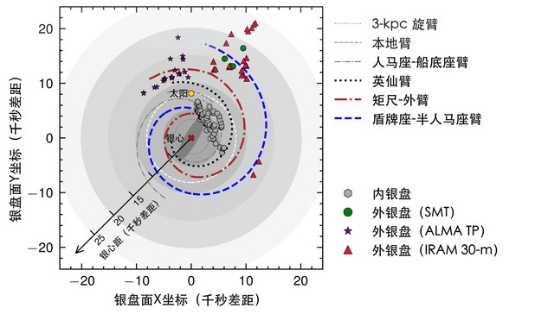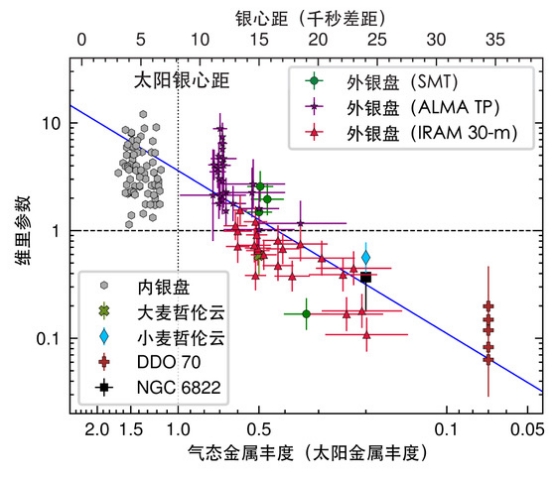Recently, the School of Physical Science and Engineering Technology, as the main collaborator, has made significant progress in the observation of molecular clouds in the outer disk of the Milky Way. The research results were published in Nature Astronomy under the title of “Inadequate turbulent support in low-metallicity molecular clouds”. The corresponding author of the paper is Zhang Zhiyu, professor of Nanjing University, and Wang Junzhi, professor of Guangxi University. The first author is Lin Lingrui, doctoral student of Nanjing University, with co-authors from various organizations at home and abroad. The research was supported by the National Natural Science Foundation of China and Guangxi University Research Fund.
Using a molecular gas probe (13CO molecular emission line), the team made map-forming observations of a batch of molecular clouds at silver-centered distances of 10 to 25 kiloseconds apart (kpc) (e.g., Fig. 1). Comparing this with data from the inner silver disk and nearby metal-poor dwarf galaxies, the team found that the low-metal molecular clouds differ significantly from the metal-rich molecular clouds in the solar neighborhood in terms of their dynamical state.

Fig. 1 Distribution of molecular cloud samples on the Galactic disk
The figure shows models of the spiral arms from the Bar and Spiral Structure Legacy Survey, including: the 3-kpc spiral arm (gray dotted line), the local arm (gray dashed line), the Centaurus-boat-base arm (gray dotted line), the Ensign arm (black thick dotted line), the Momentum-outer arm (brown thick dotted line), and the Shield-Centaurus arm (blue thick dashed line ). The gold dots and red crosses indicate the positions of the Sun and Galactic Center. The white dotted line indicates the solar orbital circle. Purple stars, red triangles, and green dots denote outer disk molecular clouds observed through the ALMA Total Power (TP), IRAM 30-meter telescope, and SMT, respectively. The gray hexagon indicates the inner disk molecular cloud from the Galactic Ring Survey.
It is shown that the turbulence intensity of the molecular cloud (characterized by velocity dispersion) decreases significantly as the silver-centered distance increases. The molecular clouds in the inner disk tend to be “hypervirialized”, i.e., the turbulence is sufficient to resist self-gravitational collapse. In contrast, the molecular clouds in the outer silver disk are generally “sub-Virilliized”, i.e., the turbulence-dominated kinetic energy is insufficient to support their self-gravitational potential. The metal abundance of the outer disk is only about 20% of the solar metal abundance, comparable to the low-metal environments of neighboring dwarf galaxies. The researchers found that the molecular clouds of neighboring dwarf galaxies are also in a state of “sub-Virginization”. The molecular clouds in the inner and outer disks of the Milky Way and in nearby dwarf galaxies conform to a trend in which the virialization state (characterized by the virialization parameter; proportional to the ratio of the kinetic energy of the molecular cloud to its self-gravitational potential) varies systematically with the metal abundance (Fig. 2). This implies that the metal abundance may have an important effect on the molecular cloud turbulence strength and dynamical state.

Fig. 2 Variation of molecular cloud virial parameters with gaseous metal abundance
In addition to the molecular clouds in the Milky Way, molecular clouds in nearby metal-poor dwarf galaxies, i.e., the Large Magellanic Cloud, the Small Magellanic Cloud, NGC 6822, and DDO 70, are included in the figure.The horizontal black dashed line indicates that the virial parameter is equal to unity (i.e., classical virial equilibrium), the vertical black dotted line indicates the Sun's silver-centered distance, and the solid blue line indicates the fitting of the trend of molecular clouds in the Milky Way.
The Nature Astronomy is a sub-journal of the Nature Publishing Group, dedicated to publishing original research papers, reviews and news reports in the field of astronomy, such as the origin of the universe, star formation, galaxy evolution and planetary systems.